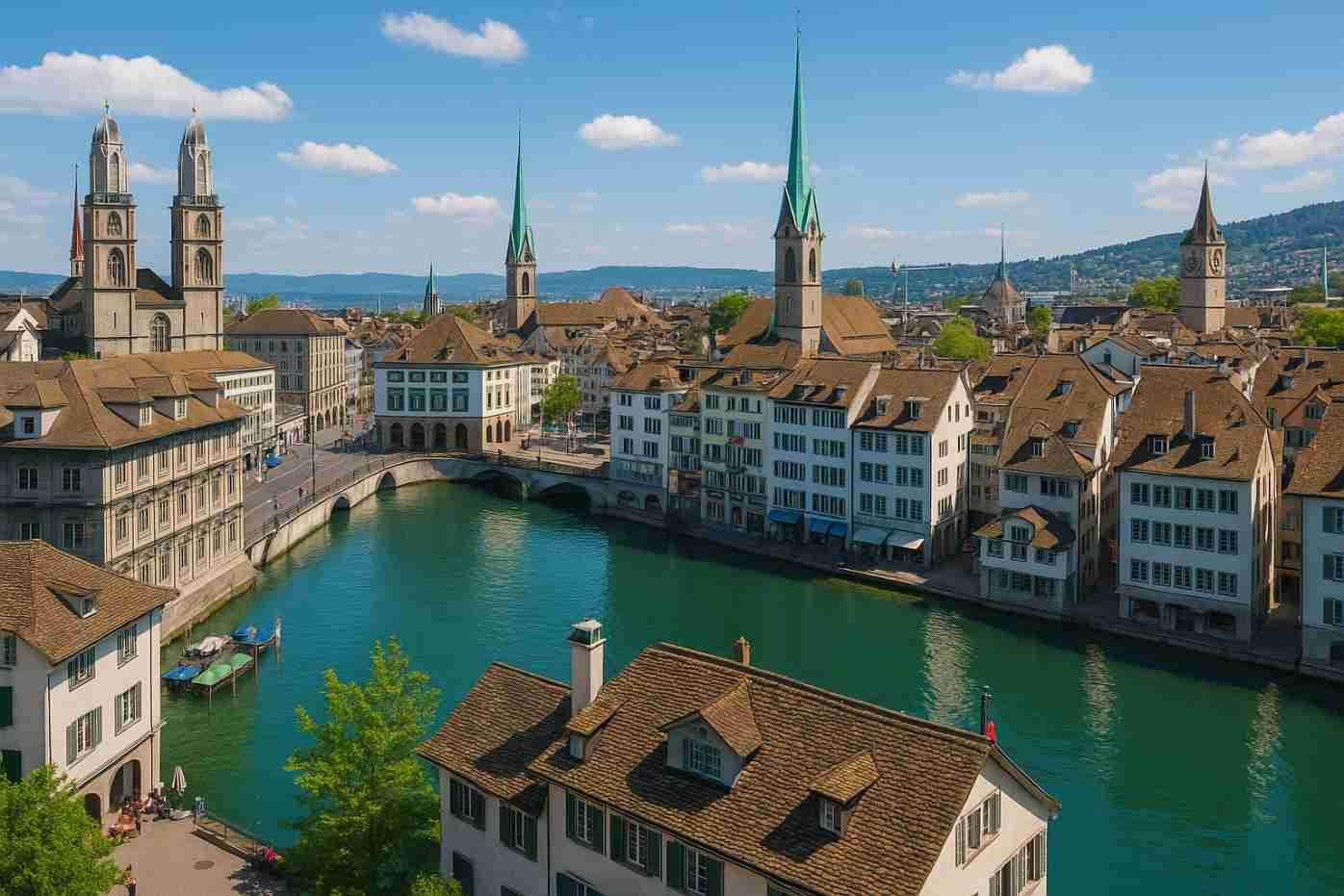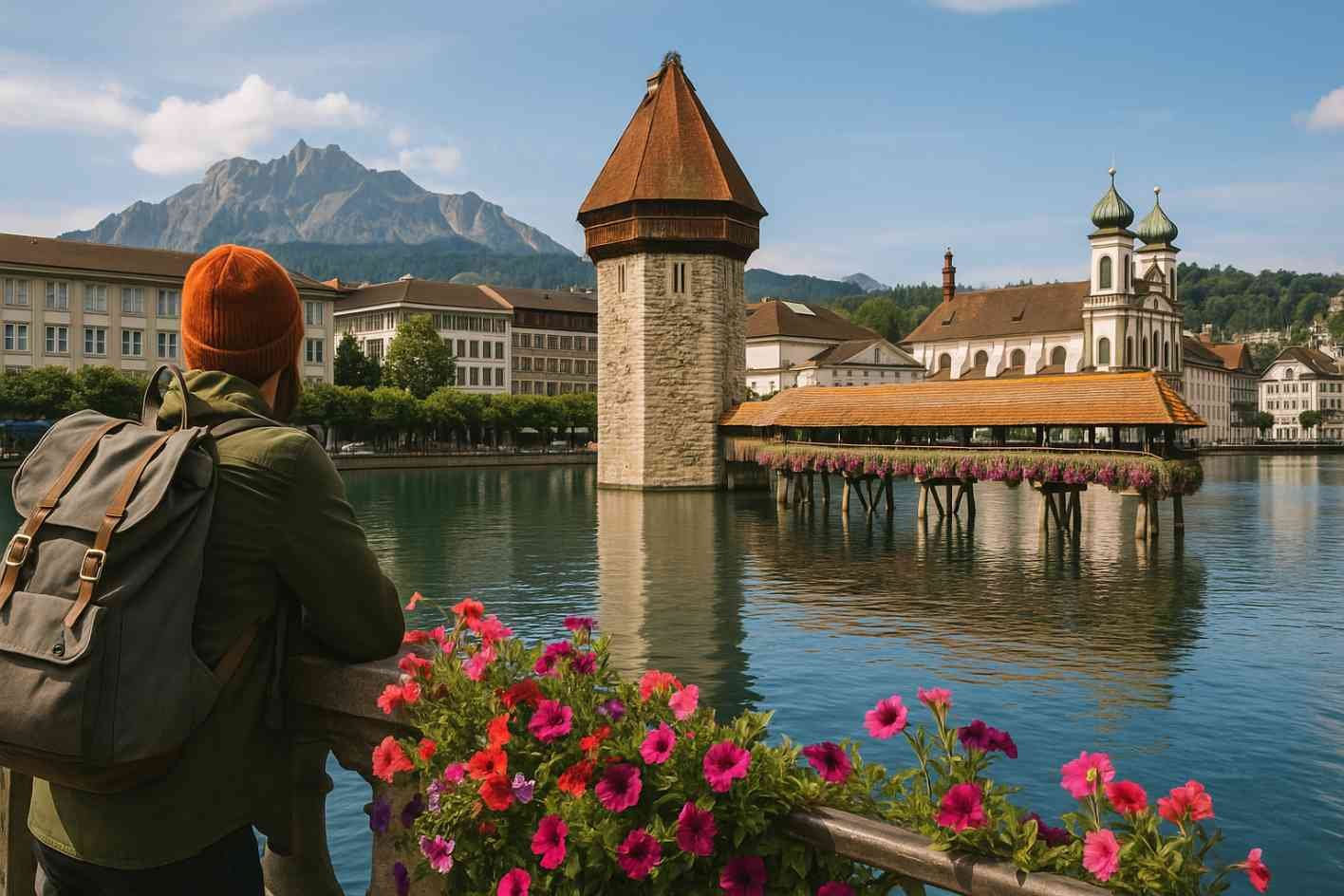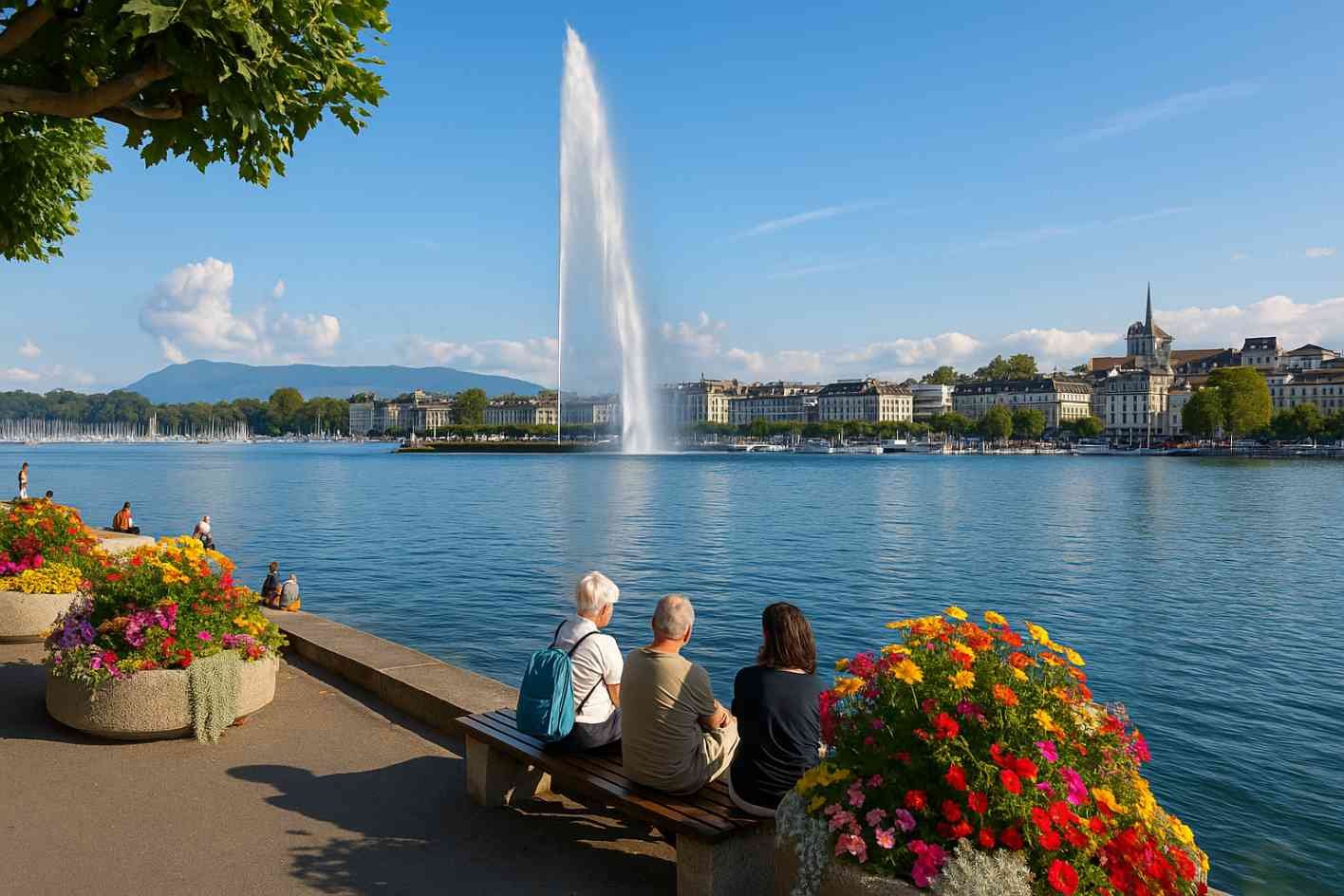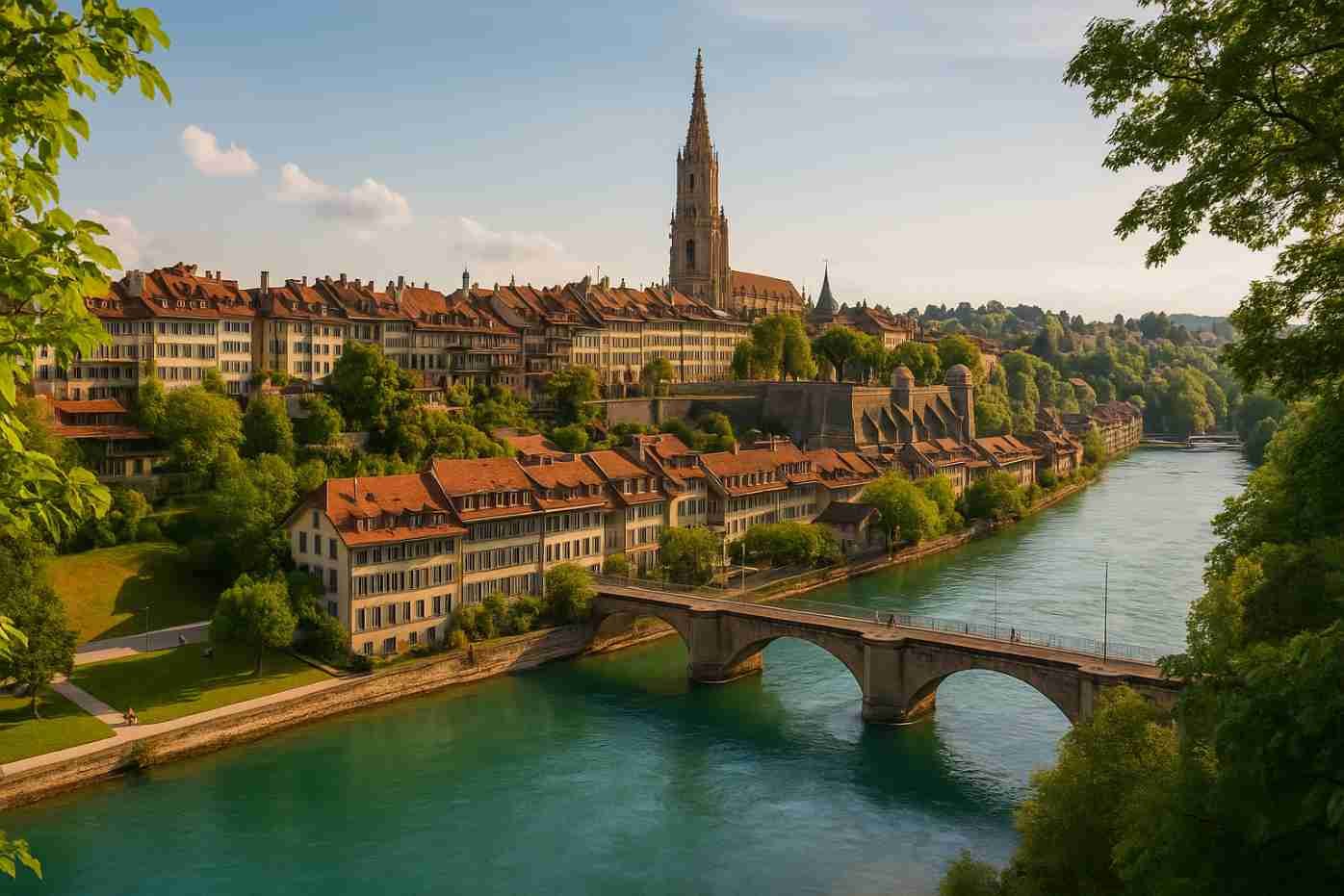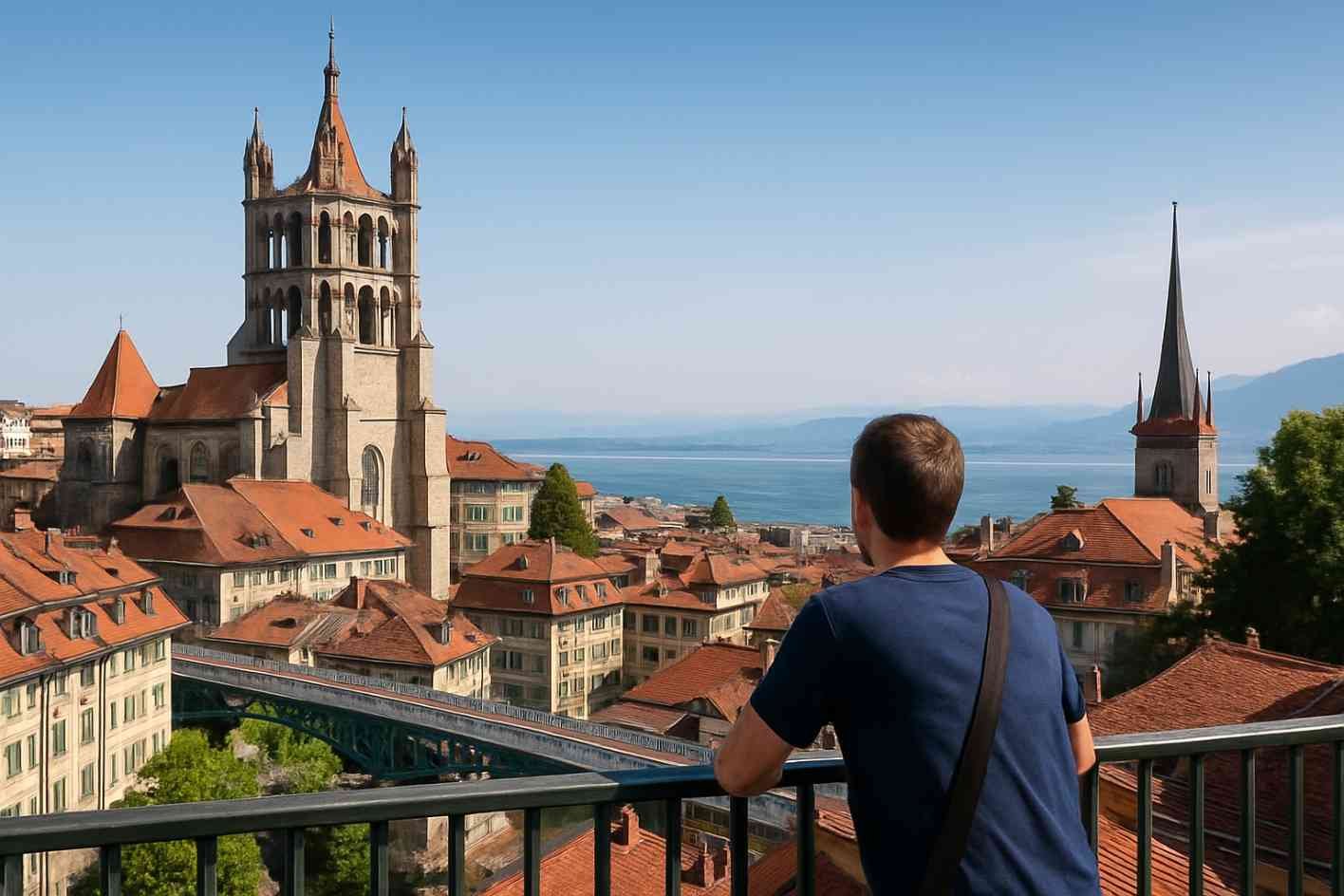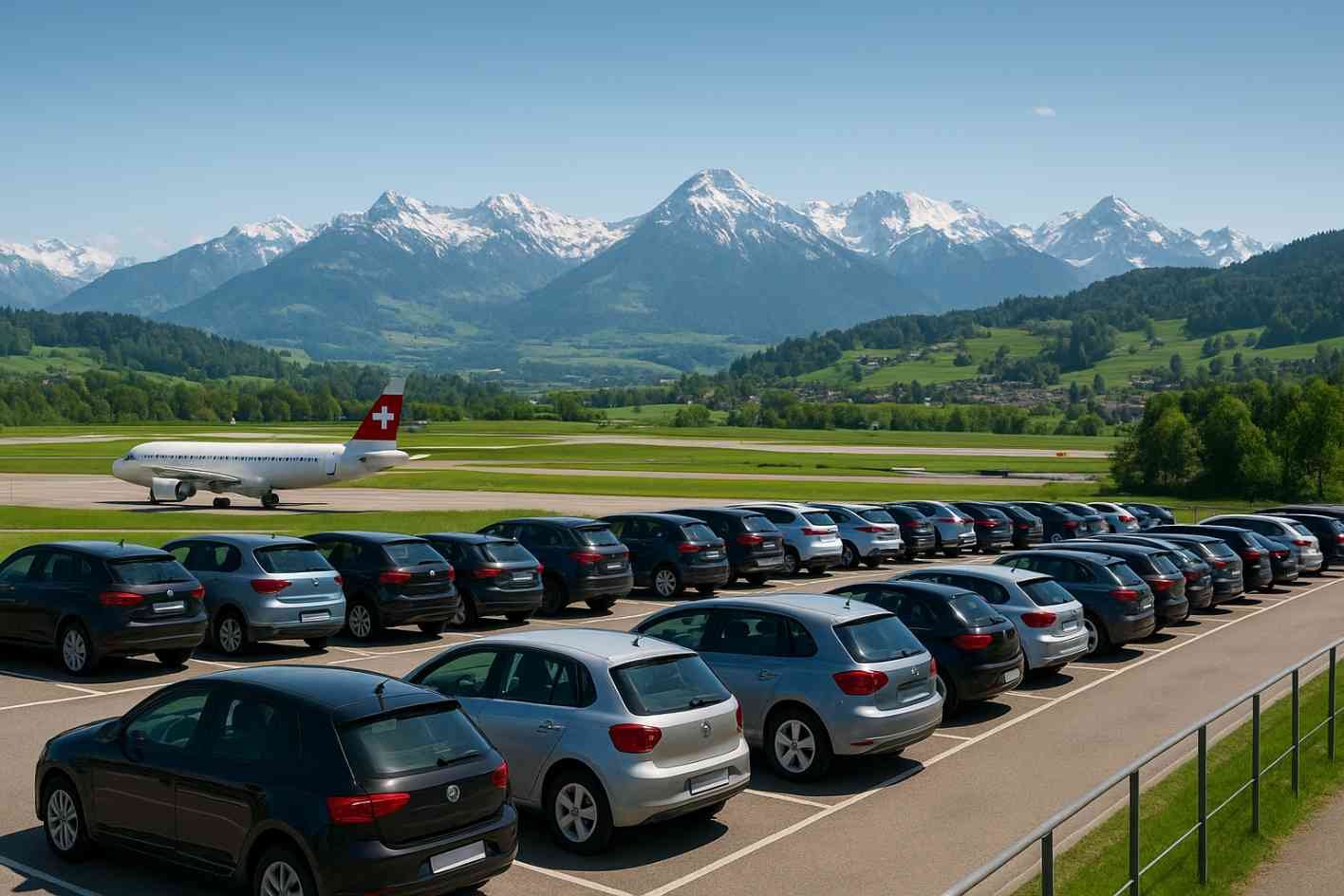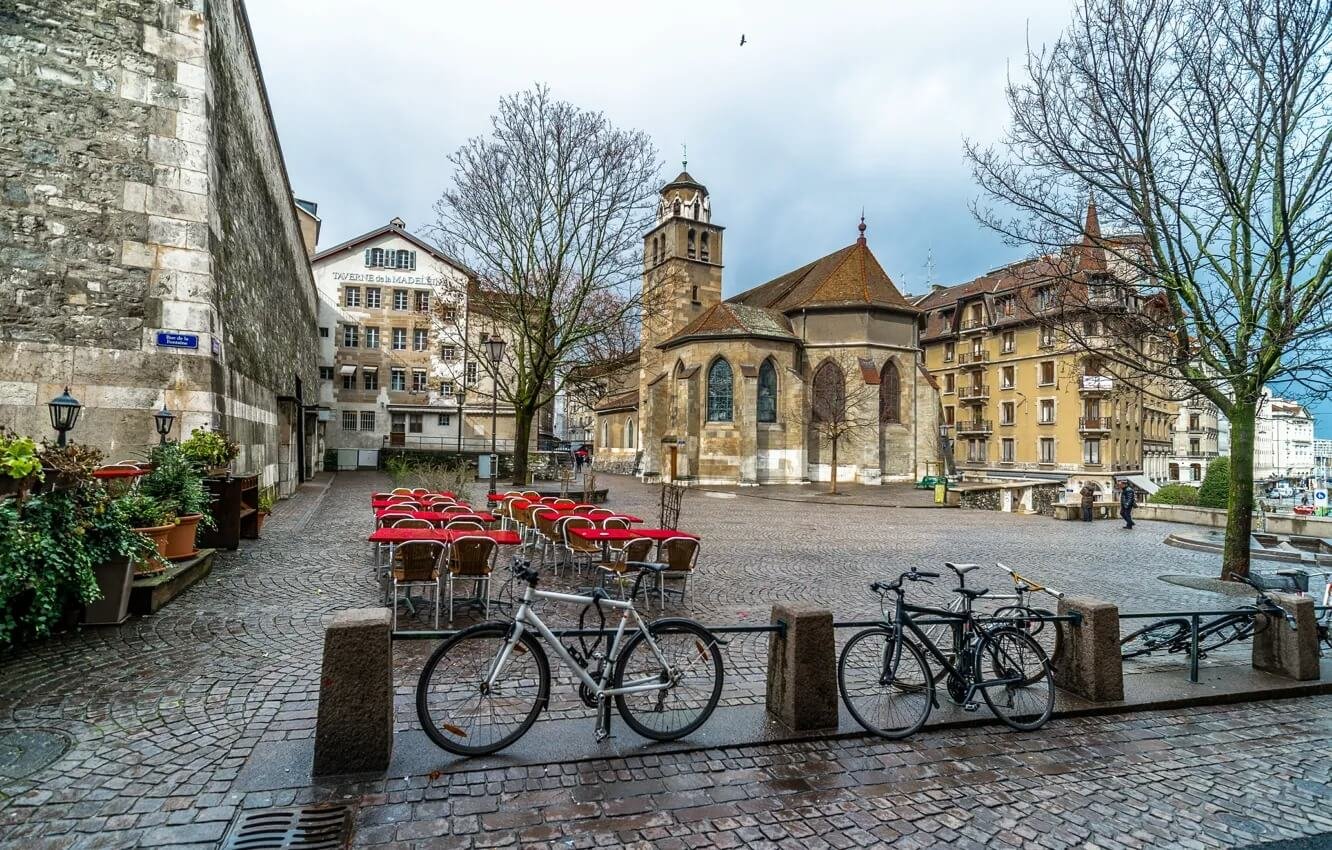I still remember my first weeks here, eyes wide, drawing in breaths of clean mountain air and utterly confounded about where I was supposed to park my car. On one hand, I was, for a while, in my element, flirting with the impossibility of not having made the perfect choice for a place to sit, and five minutes later, I was staring at a parking ticket jammed beneath the windshield of my car. It wasn’t really about the money. It was about not knowing the rules, the subtle, unspoken details about parking lots in Switzerland that no tourist brochure or guide to relocating ever manages to articulate.
That’s exactly why I’m writing this guide.
Whether you live in Switzerland all year or are simply visiting, parking may seem a quiet ordeal of its own. The signs are written in French, German or Italian, the Swiss parking zones are colour-coded like a Rubik’s cube, and the rules are enforced with Swiss-level precision. Miss a detail? You might be facing a fine or, worse, a towed car.
But once you learn the mechanism, the Swiss parking system is among the most efficient you’ll ever encounter. That’s the beauty of this country: It’s dedicated to order, fairness, and simplicity. You just need someone to explain it to you like a human, not like a government pamphlet. That’s where I come in.
In this guide, I am going to take your hand and guide you through everything, no fussing, no confusion here. Just real tips from real experience.
We’ll cover the dos and don’ts, the unexpected quirks, and the little things that can make a big difference.
Because at the end of the day, my mission with Swiss Sustain is simple:
To make life in Switzerland easier, smoother, and better-informed through real advice, not guesswork.
Let’s start with understanding why parking here is a bit different from anywhere else…
 Why Parking in Switzerland is Unique
Why Parking in Switzerland is Unique
If there is one thing that best personifies the Swiss mentality, it is parking. Neat lines, clear signage, and rules that aren’t there as guidelines, they’re gospel. I mean, I thought, How hard could parking be? But with parking lots in Switzerland, I very soon found out that parking has an entirely different meaning! It’s a complete system based on discipline, economy and trust.
In truth, one of my first experiences with parking in Swiss cities was unforgettable. I parked in what appeared to be a regular spot on a quiet side street in Zurich, only to return to see a 40 CHF fine for not having the parking disc adjusted. It wasn’t intentional, just my error, but still, it was a reminder: everything here functions like a machine, and that means you, too, are supposed to park like a machine.
The Swiss Philosophy: Fairness & Order
Switzerland values shared spaces and mutual respect. Switzerland’s parking zones are colour-coded, well-marked, and designed with fairness in mind. For example:
- Blue zones offer you free short-term parking, provided you have a disc.
- White zones are paid, with competitive and consistent pricing.
- Yellow zones? Reserved or private. No grey area. No, just five minutes.
And that structure pretty much ensures that plenty of people get the chance to have a fair shot, whether you’re a tourist, a local or an expat. But it also means that if you don’t play by the rules, there are consequences.
Fines: Real, Quick, and Non-Negotiable
Swiss enforcement is no joke. Parking tickets are written fast, adjudicated swiftly, and seldom contested with success. There is no talking your way out of that. And honestly? I like that, because that’s what keeps the system going.
A friend visiting from the U.S. once said to me, It’s like the parking police here have teleportation powers. She wasn’t wrong.
But, when you get the hang of it, you realize that it actually makes life easier. You always know where you are. No guessing. No hidden rules. Just clear expectations.
 White Zones (Paid Parking) – What You Need to Know
White Zones (Paid Parking) – What You Need to Know
Let’s start with the most common type of public parking in Switzerland: the white zones. If you see parking spaces marked with white lines, you’re in a paid public parking area, and that usually means two things:
- You’re close to a busy area (city centre, shopping street, train station)
- You’ll need to pay for your spot either at a ticket machine or via an app
Sounds simple enough, right? It is, once you know how it works.
How It Works
You pull into a white-lined parking spot and look around for a nearby ticket machine, usually just a few steps away. Most of them will have a sign above in German, French, or Italian, depending on the region. Don’t panic if you don’t speak the language. The icons are intuitive, and many machines offer English as an option.
You simply:
- Enter your license plate number or parking spot number (varies by machine)
- Select how long you want to park
- Pay by card, coins, or app (if the area supports it)
- Place the ticket clearly on your dashboard (unless the machine logs it digitally)
Important: Some areas still require the ticket even if you pay digitally. Always check the instructions on the meter! It’ll usually say ticket to display if it’s necessary.
Personal Experience
I remember once parking in Lugano on a sunny afternoon and paying for 90 minutes, sticking the ticket on the dash, and going for a lakeside walk. I lost track of time (those lake views will do that) and came back about 20 minutes late. Sure enough CHF 40 fine is waiting for me. Totally fair, and honestly? A good reminder to set an alarm on my phone.
Tip: Always set a timer on your phone right after you pay, especially in cities like Zurich, Geneva, and Basel. They don’t mess around with time limits.
Parking Apps That Make Life Easier
Thankfully, you don’t always need coins or a ticket machine anymore. These parking apps are real game-changers, especially in cities:
ParkingPay
- Used across many Swiss municipalities
- Let’s you start, extend, or stop your parking session
- Great for avoiding fines if your plans change
EasyPark
- Super popular in Europe
- Works in major Swiss cities
- You can start and stop parking remotely, no more rushing back to your car
Twint (Swiss-only users)
- Some meters let you scan a QR code and pay directly through Twint (a widely used Swiss mobile payment app)
Pro Tip: Set up these apps before your trip or move. That way, when you find a spot, you’re not standing there downloading and verifying your account in the middle of the street.
Typical Rates (Rough Estimate)
- CHF 1.50 – 2.50/hour in small to mid-sized towns
- CHF 3.00 – 5.00/hour in cities or near train stations
- Some garages charge per 15 minutes, so always read the details
Maximum parking times vary, but are usually 1–2 hours in central areas, and longer in less busy zones. Check the signs closely—Switzerland loves precision.
TL;DR:
- White zones are paid parking spots marked by white lines.
- Use ticket machines or apps like ParkingPay and EasyPark
- Set a timer to avoid overstay fines
- Read signs carefully each city can have slightly different rules
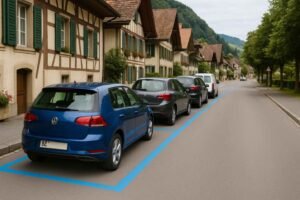 Blue Zones (Disc Parking) – The Swiss Short-Term Secret
Blue Zones (Disc Parking) – The Swiss Short-Term Secret
Ah, the famous blue zones of Switzerland. If you’ve ever driven through a Swiss town and seen rows of cars parked with no tickets visible, you’re probably looking at a blue zone one of the most common features of parking lots in Switzerland. This system is brilliant, but only if you know how it works.
I’ll be honest, when I first moved to Switzerland, I completely misunderstood blue zones. I thought, Free parking? Great! and went shopping for hours… only to return to a CHF 40 fine. Turns out, it’s free, but not unlimited, and you must use a blue parking disc (Parkscheibe) to do it right.
Let me walk you through everything you need to know.
What Is a Blue Zone?
- Marked by blue lines on the road or parking spaces
- Found mostly in residential areas, small towns, or near local shops
- Allows free parking, but only for a limited time
- You must use a blue parking disc to indicate your arrival time
It’s a great system designed to give everyone a fair chance to park, run errands, or stop by a friend’s place, without paying a cent.
How the Blue Disc System Works
Here’s how to use a blue zone correctly:
- Buy a blue parking disc – They’re sold at gas stations, post offices, convenience shops (often under CHF 5), or online.
- Set your arrival time to the nearest half hour. So if you arrive at 10:10, set it to 10:30.
- Place the disc on your dashboard, clearly visible through the windshield.
- Stick to the time limit, usually 1 hour in urban areas.
Typical Validity Times:
- Monday to Saturday between 8:00 a.m. and 6:00 p.m.
- Free overnight, on Sundays, and on public holidays
- In some rural areas, the free time can extend up to 90 minutes or even 2 hours check the sign!
Common Mistakes to Avoid (I’ve Made a Few…)
Forgetting the Disc
I’ve done this parked quickly to grab bread at the bakery and forgot the disc. Even for a 10-minute stop, that fine arrived like Swiss clockwork.
Setting the Wrong Time
Set it to the next nearest half hour, not the exact minute you parked.
Overstaying
There’s no grace period. If your disc says 10:30, you need to be gone by 11:30 sharp in a 1-hour zone. Not 11:40. Not 11:35.
Moving Your Car 2 Spaces Over
Nope, it’s not a reset. You have to leave the entire blue zone before you can restart your time.
Pro Tips from a Local Perspective
- Always keep a disc in your glove box. I even have a backup one in my bag just in case.
- In multilingual regions, the signs may say Zone Bleue, Zona Blu, or Blaue Zone, but they all work the same.
- You can use any blue disc, even one bought in another Swiss canton.
Fun fact: The disc system is honour-based, but enforcement is strict. Swiss authorities trust you to follow the rules, but they do check.
Summary:
- Blue zones = free parking, but for a limited time
- Always use a blue disc and set it to the correct time
- Don’t push your luck or try to trick the system! It’s not worth it
- Overnight and Sunday = free and time-unlimited in most places
Want a simple win when driving in Switzerland? Master the blue zone and you’ll feel like a local in no time.
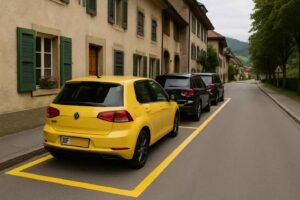 Yellow Zones (Restricted & Private Parking) – Proceed with Caution
Yellow Zones (Restricted & Private Parking) – Proceed with Caution
If you’ve gotten the hang of white and blue zones, you are entering the hard part: yellow zones. These spaces are designated for residents, businesses or holders of special permits. Yellow means no parking under any circumstances without permission in Switzerland, and believe you me, now is not the time to roll that dice.
What Are Yellow Zones?
- Designated with Yellow Lines In the Road or the Curb.
- Many are located in residential areas and at local businesses or loading zones
- There may be fines on the spot if you park without a proper permit, or worse, if you return to a towed car
Why You Should Pay Attention
A local friend informed me about her cousin who parked in a yellow zone next to an apartment building to quickly stop by. When she emerged, the car was nowhere to be seen. Swiss tow trucks are efficient and do not hesitate to drag cars that are parked in private or restricted spaces.
Also, the fines here can be heavier than in white or blue zones since the space should remain clear for authorised users only.
Getting Permits for Yellow Zones
If you are a resident or operate a business there, you can usually butter your local municipality up for a parking permit. The process can differ from canton to canton and city to city, so consult your local government website or office for more information.
Note that permits can be in short supply, especially in popular destinations such as Zurich or Geneva. Instead, many residents are left parking at public garages or utilising park-and-ride facilities.
Local Insight
In parts of Switzerland, yellow zones are stringently enforced around the clock, but in other places, there may only be limitations during work hours or specific days. Always check the signs that go with the bay – they’ll tell you the specific rules for that zone.
Recall: Switzerland likes order, and it likes fairness. Parking in a yellow zone without authorisation is disrespectful, as proven by the actions the authorities take.
Quick Takeaway:
- Yellow = no parking without permits
- Risk of fines and towing
- Residents/businesses can obtain permits via the local authority
- Always read signs closely, restrictions vary by location and time
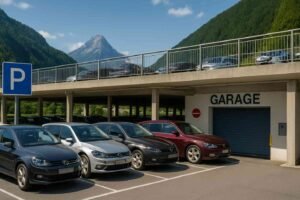 Public Parking Lots & Garages – What It’s Really Like
Public Parking Lots & Garages – What It’s Really Like
Let me say this upfront: Swiss public parking garages are some of the cleanest, safest, and most organised I’ve ever used. But that doesn’t mean it’s always smooth sailing, especially if you’re new here or coming from a country where underground parking is a chaotic mess.
The first time I used a parking garage in Lausanne, I was genuinely impressed. The floors were spotless, the signs were crystal clear, and no joke, it even smelled clean. But then came the machine. The infamous moment when I realised I had no idea how to pay.
Let’s talk about how these garages work, what to expect, and how to make your life easier.
How Swiss Parking Garages Work
Most public garages (especially in cities or near train stations) are:
- Underground or multi-level
- Well-lit and secure, often with CCTV
- Clearly marked by signs saying Parking or Parkhaus
Here’s the basic flow:
- Enter – The barrier opens automatically or gives you a ticket.
- Park – Usually, spaces are clearly numbered and colour-coded (some even show red/green lights for occupied/available spots).
- Pay before you return to your car – Look for a central payment machine.
- Insert your ticket and pay – Most machines accept card, cash, or Twint (Swiss mobile payment).
- Return to your car and exit – Use the paid ticket at the exit barrier.
Real-Life Struggles
Here’s where I tripped up my first few times:
- I tried to pay at the exit barrier like in some other countries. Not how it works here. You need to pay at the machine before returning to your car.
- Some garages give you a ticket when entering, but others now use license plate scanning. That threw me off, especially when no ticket came out, and I panicked thinking the machine was broken.
- One time in Interlaken, I left my paid ticket inside the car… then couldn’t get out of the barrier without running back and grabbing it. Lesson learned: always keep it in your pocket until you’re out!
Payment Tips
- Most machines accept Visa, Mastercard, and Twint
- Some also take CHF coins, but not always notes
- Newer garages now have contactless tap-and-go (super convenient)
Pricing: What to Expect
Prices vary by location, but here’s a rough idea:
- Small towns: CHF 1.50 – 2.50/hour
- City centres (Zurich, Bern, Geneva): CHF 3 – 5/hour
- Train stations or airports: CHF 25 – 40/day
- Many garages offer discounted evening rates (like CHF 1/hour after 7 p.m.)
Tip: Some garages display rates by 15- or 30-minute intervals, so it’s not always an even hourly charge.
Where to Find Them
Public garages are well-distributed in:
- City centers
- Near tourist attractions
- Train stations (P+Rail)
- Shopping districts and malls
Use apps like Parkopedia or ParkingPay to see live availability and pricing in some areas.
Key Takeaways:
- Public garages in Switzerland are clean, safe, and efficient
- Always pay before returning to your car
- Use apps or credit cards to avoid scrambling for coins
- Double-check signage and machine instructions (they’re usually multilingual)
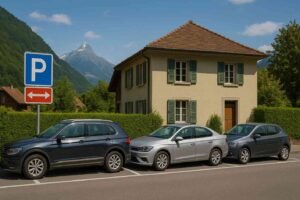 Residential Parking – Permits, Mixed Zones & How to Apply
Residential Parking – Permits, Mixed Zones & How to Apply
Living in Switzerland? So let’s turn to one of the most pressing matters about parking for residents: where to park your car next to your home without fear.
And unlike some countries where you can kind of just park on the street and hope for the best, Swiss residential parking is highly regulated, and I’m honestly grateful for that. It maintains such decency and fairness within neighbourhoods. But yes, it’s a little confusing at the outset.
How Residential Parking Works
In most towns and cities, local residents are eligible to apply for a residential parking permit (known as a Bewilligung or macaron de stationnement in some cantons). This allows you to park:
- In designated residential zones
- Often without time limits
- Always near your location (not anywhere in the city)
They are usually zones designated with signs reading Parken mit Bewilligung” or “Stationnement autorisé avec macaron.
What Are Mixed Zones?
Some places heave mixed-use zones, which require your resident’s (or visitor’s) permit, and there’s also the blue disc crew and meter payers. This is typical in older neighborhoods with dense blocks.
It means:
- Visitors can park short-term
- Car owners holding a permit can park for long periods of time.
I am someone who lives in a zone like that, so, knock wood, this system has been a godsend. And I’m not at the point of daily fines, and friends can still come over with no problem.
How to Apply
You can apply for a permit on your local commune or city’s website. You’ll typically need:
- Evidence of residence (lease or utility bill)
- Vehicle registration
- the output One possibility is a modest annual fee (CHF 200–400, depending on the location)
Apply as early as possible, especially in popular cities such as Zurich and Lausanne, where places are limited.
Tip: Don’t forget to update your permit if you move or buy a new car. Swiss cities are very serious about detail matching.
Highway Parking & Park + Ride (P+R) – Smart Stops & Budget Wins
Perhaps as you’re road-tripping your way around Switzerland, or commuting into the city, you’ll appreciate just how easy the highway and Park + Ride (P+R) parking systems are to use. So they are built with that archetypal Swiss logic: safety, simplicity and common sense.
Allow me to explain how they work and how they’ve saved me money (and hassle!) more than once.
Highway Parking – Rest Stops Done Right
You can find rest areas (Raststätten or Aires de repos) approximately every 30–50 km if you are travelling Swiss highways. They include:
- Free parking (typically with a 2-hour limit)
- Toilets, picnic areas and snack stalls
- Some even offer EV charging, showers, and mini-markets
Pro Tip: If you are camping or want a longer rest, consider seeking Autobahn-Rastplätze mit Übernachtung. A few even offer overnight accommodations, sometimes for a nominal price.
Personal note: I once napped at a pristine rest stop near Lucerne, and felt super safe and woke up to cowbells as a background sound. Only in Switzerland.
Park + Ride (P+R) – Park Outside, Train In
Don’t want to navigate the congestion in places like Zurich or Geneva? Use P+R lots! These are:
- Large car parks near train or tram stations
- Much cheaper than city-centre garages
- Connected to frequent public transport
Daily rates: CHF 5–15
Monthly passes are available in many locations
Often located in suburbs like Bern Wankdorf, Zurich Sihlcity, or Lausanne Vennes
Local Tip: Use the SBB app or ParkingPay to locate nearby P+R spots and check availability in real-time.
Best Parking Apps in Switzerland – Park Smart, Stress Less
Let’s face it: parking in Switzerland can be hard, especially in busy cities or unknown towns. But there’s good news: there are some great apps that take the work out of it all. After experimenting with many (and screwing up royally more than a few times along the way), I now use these apps consistently.
1. ParkingPay – My Top Pick
Use for: Paying public parking meters, managing residential permits in some towns
- Operates in more than 450 Swiss cities and municipalities
- Allows you to initiate, end, or extend parking sessions
- Displays parking zones you can park near you
My experience: I use ParkingPay almost daily here in this beachside city. It’s dependable, no-nonsense and has bailed me out of fines and obesity inducing numbers of times.
2. EasyPark – For City Parking & International Use
Use it for: Paid street parking in cities like Zurich, Geneva, Basel
- Functions across many nations, making it ideal for travellers
- Can not find any dirt on the interface either. Automation include,d and it should also have automatic zone detection.*
- You receive reminders in advance of the time running out
Good for if you’re planning an all-encompassing European road trip, not simply in Switzerland.
3. Twint (QR Pay) – Quick & Swiss-Specific
Use it for: Paying for parking with your phone
- It doesn’t get any easier than that, simply scan the QR code off the parking machine
-
Linked to your Swiss bank account
- No coins, no need to download any apps (if you are already using Twint)
Note: Works best if you live in Switzerland, as Twint needs a local bank connection to function.
Bonus App: Parkopedia
Discover parking garages, compare prices and read about opening hours, which can be particularly useful in large cities.
Final Tip: Be sure to download ParkingPay and EasyPark before you leave. They take care of nearly all use cases and simplify your parking life by 10x.
Common Parking Mistakes & Fines in Switzerland – Learn the Easy Way
Let’s face it: Swiss parking rules can be strict, and the fines are real, not just scare tactics. I’ve lived here long enough (and paid enough in fines) to say this with confidence: parking mistakes in Switzerland are easy to make but even easier to avoid once you know what to watch for.
Let me walk you through the most common errors (some personal!), how to avoid them, and what happens if you don’t.
Mistake #1: Forgetting the Blue Disc in a Blue Zone
Sounds small, right? But the fine isn’t.
Personal story: I once parked outside a Coop in a sleepy village, ran in for 15 minutes, and came out fine under the wiper. I hadn’t put out the blue disc. It was only CHF 40, but it felt brutal for such a quick stop.
Tip: Always keep a blue disc in your glovebox. Even better: one in your bag too, just in case.
Mistake #2: Overstaying Paid Parking
Many machines or apps don’t notify you when time is running out! It’s up to you. If you’re even 10 minutes over, you risk a fine (CHF 40–CHF 80 depending on the location).
Tip: Use ParkingPay or EasyPark, which remind you and let you extend time remotely.
Mistake #3: Parking in a Yellow Zone Without a Permit
You see an empty space in a quiet neighbourhood and think, Perfect! But if it’s yellow-lined, it’s almost always private.
I made this mistake once in Geneva. Towed within two hours. The total cost? CHF 250+ (fine, towing, admin fees). I definitely learned my lesson.
Mistake #4: Ignoring Local Signage
Some areas have odd-even rules, limited Sunday parking, or temporary restrictions for street cleaning.
Always read the signs. Even if they look confusing, they usually include icons or colour codes to help.
Fines in Switzerland – What to Expect
- Blue disc error: CHF 40
- Overstaying paid parking: CHF 40–60
- Wrong zone/no permit: CHF 80+
- Towing (especially in yellow zones): CHF 150–300
Final Tip: If You Get Fined…
Pay promptly. Delays add penalties fast. Most fines include a payment slip (Einzahlungsschein) and instructions.
Moral of the story? Respect the rules, double-check signage, and use a parking app. Parking in Switzerland is fair, but not forgiving.
Swiss Parking Etiquette – What Tourists Don’t Expect
Switzerland isn’t just known for clean streets and punctual trains! The same order and respect for rules extends to how people park. It’s not just about legality here! It’s about etiquette, too.
Honestly, I didn’t fully understand this until I lived in a Swiss neighbourhood for a while. People notice how you park. And they remember.
1. Park Neatly – Always
In Switzerland, parking between the lines is a social contract. Even if there’s no one around, a crooked or “creative” park job is a big no-no.
I once parked slightly over the line at a Coop, still within my spot, but not perfectly straight. I returned to a passive-aggressive note on my windshield… in perfect German grammar.
Tip: Adjust your car if it’s even a little askew. It’s not just about space, it’s a sign of respect.
2. No Honking, No Revving
Noise is a big deal in Switzerland. Starting your car late at night or slamming doors in a quiet residential area won’t go unnoticed.
Many garages even have signs asking drivers to cut the engine quickly to reduce pollution and noise.
3. Don’t Take Resident Spots – Even Temporarily
If a space is labelled Privé, Privat, or shows a license plate number, don’t touch it.
Even stopping for “just a minute” to answer a text or check a map is frowned upon.
Quick Tips – Parking in Switzerland (Dos & Don’ts)
Here’s your no-fuss recap of what to remember when parking in Switzerland, whether you’re a local or just visiting.
DOs:
- Use a blue parking disc in blue zones and set it properly!
- Download parking apps like ParkingPay or EasyPark before you need them
- Check all signs and road markings carefully
- Pay before returning to your car in the garage
- Respect residential zones, get a permit if needed
- Keep coins or Twint handy for older meters
- Use Park + Ride lots to save money in big cities
- Park within the lines always (yes, always!)
DON’Ts:
- Don’t assume you can park for “just a minute” in yellow zones
- Don’t forget to set a timer, or you might return to a fine
- Don’t block sidewalks or bike lanes — even partially
- Don’t ignore overnight or weekend restrictions
- Don’t expect leniency, Swiss fines are punctual and precise
Final Thoughts – Parking in Switzerland Doesn’t Have to Be Stressful
If you’ve got this far, thank you! That type of already says a lot about the kind of traveller (or local) you are: thoughtful, curious and prepared. And that is Switzerland’s exact reward: thinking ahead, being meticulous and respecting the system.
Yes, parking here can feel stringent at first. But once you learn the rules, it’s actually easy, efficient and yes, refreshing. A place for everything, and everything in its place, including your car.
From receiving my first parking fine, to assisting my friends and family with confidenc,e trying to park and scrabble for a spot I know all too well, but the hard way, so that you don’t have to.
Your Turn: Did you find this guide useful? Pass it along to someone who’s heading to Switzerland! Still have a query or a parking tale to tell? Stick it in the comments, I’m eager to hear from you. Planning to live or travel here? Bookmark this page, it might just save you CHF 100 someday.
Be it smart, be it civilised and park like a pro in Switzerland.
If this parking guide helped you, here are three more articles you shouldn’t miss:
What Language Is Spoken in Switzerland? – Make your Swiss trip smoother by understanding the country’s unique language setup.
Best Hotels in Interlaken – Handpicked hotels with the best views, value, and comfort in Interlaken.
How to Save Money Traveling in Switzerland – Smart travel tips to cut costs without missing out on anything.




